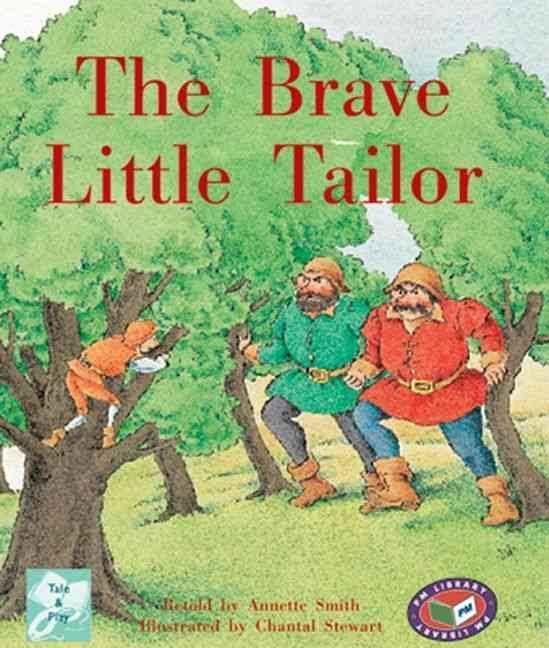Aarne-Thompson grouping 1640 Originally published 1812 | Published in Grimm's Fairy Tales | |
 | ||
Also known as The Brave Little Tailor Related Similar Brothers Grimm books, Other books | ||
The brave little tailor
"The Brave Little Tailor" or "The Valiant Little Tailor" or "The Gallant Tailor" (German: Das tapfere Schneiderlein) is a German fairy tale collected by the Brothers Grimm, tale number 20. Joseph Jacobs collected another variant "A Dozen at One Blow" in European Folk and Fairy Tales. Andrew Lang included it in The Blue Fairy Book. Another of many versions of the tale appears in A Book of Giants by Ruth Manning-Sanders.
Contents
- The brave little tailor
- Synopsis
- Characterization
- Motifs and themes
- Relation to other stories
- Adaptations
- References
In the Aarne–Thompson–Uther system of classifying folktales, it is type 1640, with elements of several other story types.
Synopsis
A tailor is preparing to eat some jam, but when flies settle on it, he kills seven of them with one blow of his hand. He makes a belt describing the deed, reading "Seven at One Blow". Inspired, he sets out into the world to seek his fortune. The tailor meets a giant who assumes that "Seven at One Blow" refers to seven men. The giant challenges the tailor. When the giant squeezes water from a boulder, the tailor squeezes milk, or whey, from cheese. The giant throws a rock far into the air, and it eventually lands. The tailor counters the feat by tossing a bird that flies away into the sky; the giant believes the small bird is a "rock" which is thrown so far that it never lands. Later, the giant asks the tailor to help him carry a tree. The tailor directs the giant to carry the trunk, while the tailor will carry the branches. Instead, the tailor climbs on, so the giant carries him as well, but it appears as if the tailor is supporting the branches.
Impressed, the giant brings the tailor to the giant's home, where other giants live as well. During the night, the giant attempts to kill the tailor by bashing the bed. However, the tailor, having found the bed too large, had slept in the corner. Upon returning and seeing the tailor alive, the other giants flee in fear of the small man.
The tailor enters the royal service, but the other soldiers are afraid that he will lose his temper someday, and then seven of them might die with every blow. They tell the king that either the tailor leaves military service or they will. Afraid of being killed for sending him away, the king instead attempts to get rid of the tailor by sending him to defeat two giants along with a hundred horsemen, offering him half his kingdom and his daughter's hand in marriage if the tailor can kill the giants. By throwing rocks at the two giants while they sleep, the tailor provokes the pair into fighting each other until they kill each other, at which time the tailor cuts a small mark near the giants' hearts.
The king, surprised the tailor has succeeded, balks on his promise, and requires more of the tailor before he may claim his rewards. The king next sends him after a unicorn, another seemingly impossible task, but the tailor traps it by standing before a tree, so that when the unicorn charges, he steps aside and it drives its horn into the trunk. The king subsequently sends him after a wild boar, but the tailor traps it in a chapel with a similar luring technique.
Duly impressed, the king relents, marries the tailor to the princess, and makes the tailor the ruler of half the original kingdom. The tailor's new wife hears him talking in his sleep and realizes with fury that he was merely a tailor and not a noble hero. Upon the princess's demands, the king promises to have him killed or carried off. A squire warns the tailor, who pretends to be asleep, and but then calls out that he has done all these deeds and is not afraid of the men behind the door. Terrified, they leave, and the king does not try to assassinate the tailor again. The tailor lives out his days as a king in his own right.
Characterization
Motifs and themes
In the Aarne–Thompson–Uther system of folktale classification, the core of the story is motif type 1640, named The Brave Tailor for this story. It also include episodes of type 1060, Squeezing Water from a Stone; type 1062, A Contest in Throwing Stones; type 1052, A Contest in Carrying a Tree; type 1051, Springing with a Bent Tree; and type 1115, Attempting to Kill the Hero in His Bed.
The story features several more general themes common to numerous folktales and more formal literature:
Relation to other stories
"The Brave Little Tailor" has close similarities to other folktales collected around Europe, including "The Boy Who Had an Eating Match with a Troll" (Norway) and "Stan Bolovan" (Hungary). It also shares many elements with "Jack the Giant Killer" (Cornwall and England, with ties to "Bluebeard" folktales of Brittany, and earlier Arthurian stories of Wales), though the protagonist in that story uses his guile to actually kill giants. Both the Scandinavian and British variants feature a recurring stock character fairy-tale hero, respectively: Jack (also associated with other giant-related stories, such as "Jack and the Beanstalk"), and Askeladden, also known as Boots.
The technique of tricking the later giants into fighting each other is identical to the technique used by Cadmus, in Greek mythology and a related surviving Greek folktale, to deal with the warriors who sprang up where he sowed dragon's teeth into the soil. In the 20th-century fantasy novel The Hobbit, a similar strategy is also employed by the wizard Gandalf to keep three trolls fighting amongst themselves, until the rising sun turns them to stone.
